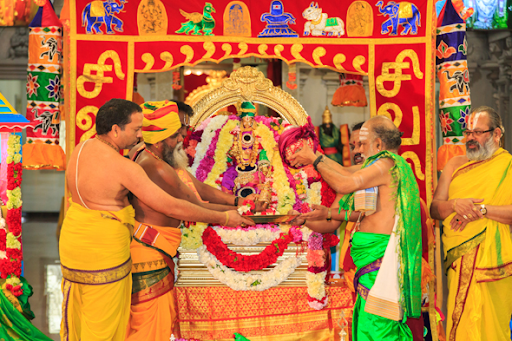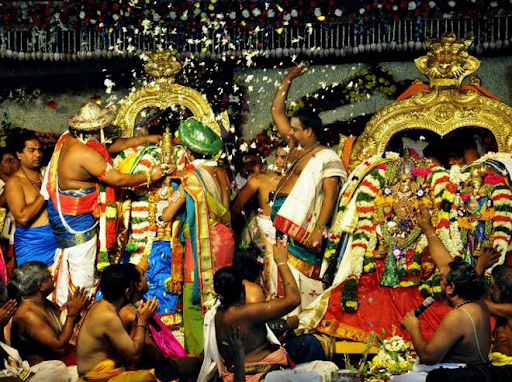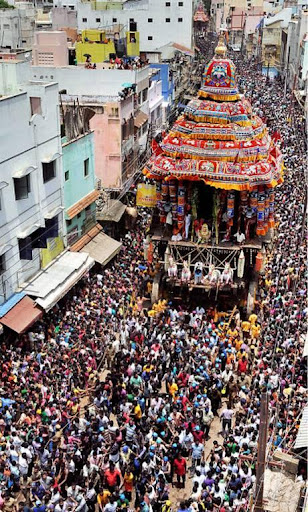Madurai city is often called the ‘City of Festivals’. Major festivals of Meenakshi temple are the Chithirai Festival, and the Avani Moolam Chithirai Festival. These are primarily meant for public benefit that occasion, and go by the name “Sambhavi Deekshai’. The festivals particularly benefit those who are unable to go to the temple and worship the Lord; the Lord himself decides to come around the streets in procession.
Meenakshi Pattabhishekam

Chithirai Festival is one such famous festival, which takes place for twelve days. On the eighth day Coronation of Meenakshi Amman is celebrated. On that occasion, the chief trustee of the temple takes the role of the Pandya King and presents the Sceptre to Goddess Meenakshi in a very impressive ceremony. After Goddess Meenakshi is crowned as the queen of the Pandya kingdom, on the ninth day of the festival, she moves around engaging in war with all the countries in the world in all eight cardinal directions and conquers the entire world. Only Tiru Kailaaya, the abode of Paramasiva remains. She enters Kailaaya but on seeing Paramasiva, her third breast disappears as was predicted would happen when she met her Consort. She dissolves in deep love for Paramasiva and preparations are made for the divine marriage ceremony of Meenakshi and Paramasiva (who descends in the handsome form of Sundareshwara as per Meenakshi’s wish that he should appear extremely handsome.)
Meenakshi Tirukalyanam

On the tenth day of the Chithirai (Vedic month of Chithirai corresponding to April-May) festival, the Divine marriage ceremony of Devi Meenakshi with Lord Sundareshwara is celebrated. The festival starts on the 5th day of the waxing moon of the Vedic month Chithirai (April-May). This takes place at the junction of the west Aadi Veedhi and the north Aadi veedhi near the Tiruppugazh Mandapam in Madurai. In this festival both Lord Subramanya and Pavalakkanivay Perumal (Lord Vishnu) also participate. Two Shaivitie priests assume the role of Sundareswara and Devi Meenakshi respectively and exchange the wedding garlands. The Tirumangalyam (a piece of jewel the bridegroom ties around the bride’s neck as the wedding knot) is presented to Meenakshi and traditional ceremonies as in any Hindu marriage are also performed.
Temple Chariot Festival
The chariot festival or Ther Tiruvizha or Rathotsavam is performed the day after Meenakshi Tirukalyanam – the divine marriage ceremony of Devi Meenakshi and Sundareshwara. The King and Queen of the Pandya Kingdom Lord Sundareshwara and Meenakshi come to see their subjects in separate well decorated chariots. The festival attracts many people in the Masi streets of Madurai as viewers.
All the big temples would usually possess a temple chariot (car) on which the presiding deities of the temple would be taken out in procession. The bigger the chariot is, the more prosperous the temple and prouder are its citizens. The celestial chariot, depending on its size, would have two to nine wheels to move around. Sundareshwarar’s Chariot is the most enjoyed by the priests of the temple and people of the city.
The Temple Chariot Construction

The first row of the temple chariot carries the images of legendary creatures from the Puranas (Hindu history) and the second layer carries those of Gods/Goddesses and a now extinct animal – Yali. It is in the third portion that one will be able to see figures of dimension 1×1.5 feet that depict the sculptures of Lord Paramasiva depicting the scenes from the Tiruvilayadal Puranam (Divine Plays of Sundareshwara). The third, fourth and fifth portions show the customary dance, and the distinctive stick dance as well. These dances would have been performed in front of the chariot in earlier years as the chariot embarked on its journey.
